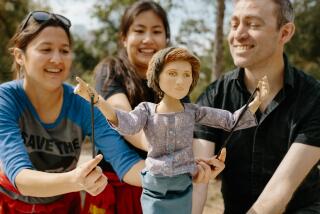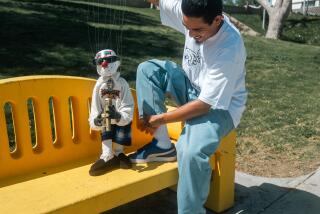Ancient Asian Puppets Raise Questions
- Share via
Imagine a compelling theatrical performance in which not a single live actor appears on stage. Avant-garde minimalism? Virtual reality? The Theater of Tomorrow?
Actually the form’s a lot older. In India it dates to at least 200 BC. It is, of course, puppetry.
The subject is brought to mind by a modest exhibition at UCLA’s Fowler Museum of Cultural History, “In the Play of Shadows: Puppets From Asia.” Put together by museum curator Roy Hamilton, it includes about 40 figures carefully selected from a holding of several hundred.
Installed on walls surrounding the building’s pleasant interior courtyard, it boasts no such bells and whistles as videotaped performances. Helped along by photographs and informative wall labels, it simply offers a chance to quietly contemplate a multimedia form that existed centuries before the term was coined.
These figures are fashioned from animal hide as thin as parchment. Jointed limbs are attached to rods that are worked from below. The literal deus ex machina of the whole thing is the puppeteer. He not only has to memorize complex texts from the great Hindu epics, the “Ramayana” and “Mahabharata,” he must provide individual voices and personalities to puppet casts that are often large. He must also have the physical stamina to lie on his back, never leaving the arena, doing plays that commonly last from dark to dawn. Characteristically, an orchestra is behind him. A translucent screen stands between puppets and the audience, which sees the figures only in silhouetted shadow.
Why is that? As we see, individual figures are wondrously expressive. They range from noble princes to comic ogres like the Balinese Twalen, who bears a “magic arrow” that’s clearly also a giant penis.
Javanese puppets are delicately aristocratic with their long slender arms and pinched almond-eyed heads. Malaysian examples are more chunky and expressionistic. Heroes are multicolored with elaborate filigreed costumes. Clowns are solid black with gold edging.
Those puppets are all of about average height, say roughly 12 inches. But Indian examples are startling large. Ranging up to 5 feet, they look like a cumbersome handful for the operator.
There is the ever-popular elephant-headed, pot-bellied glutton-clown Ganesh. Ravana has about 10 blue heads. Hanuman, general of the monkey army, looks as if he’s break-dancing and reminds modern viewers of “Planet of the Apes.”
They’re all so engaging. Why hide them behind a screen that shows only the shadows? A practical guess might be that in shadow, their sizes can be controlled by moving them closer to the light source.
A Javanese description suggests a different dimension of interpretation. “From the puppeteer’s side, the puppets show their bodies, but from the shadow side they show their souls.”
Could the shadow-theater be a parallel statement of Western philosophy’s notion of Plato’s Cave, the idea that all we know of reality is its fictive embodiment in shadow? But if that’s the case, why bother to paint the figures?
One is reminded of an old story about a medieval monk. Asked why there are elaborate carvings in parts of his church where no one can see them, he replies, “God can see them.”
Clearly there’s a rich cosmological metaphor afoot in the puppet theater that may be beyond the ken of a secular audience. One thing we certainly can appreciate is that centuries ago, the shadow-puppet theater posited all the concepts necessary to make--you guessed it--motion pictures.
* UCLA Fowler Museum of Cultural History; through Jan. 5; closed Mondays and Tuesdays, (310) 825-4361.
More to Read
The biggest entertainment stories
Get our big stories about Hollywood, film, television, music, arts, culture and more right in your inbox as soon as they publish.
You may occasionally receive promotional content from the Los Angeles Times.










